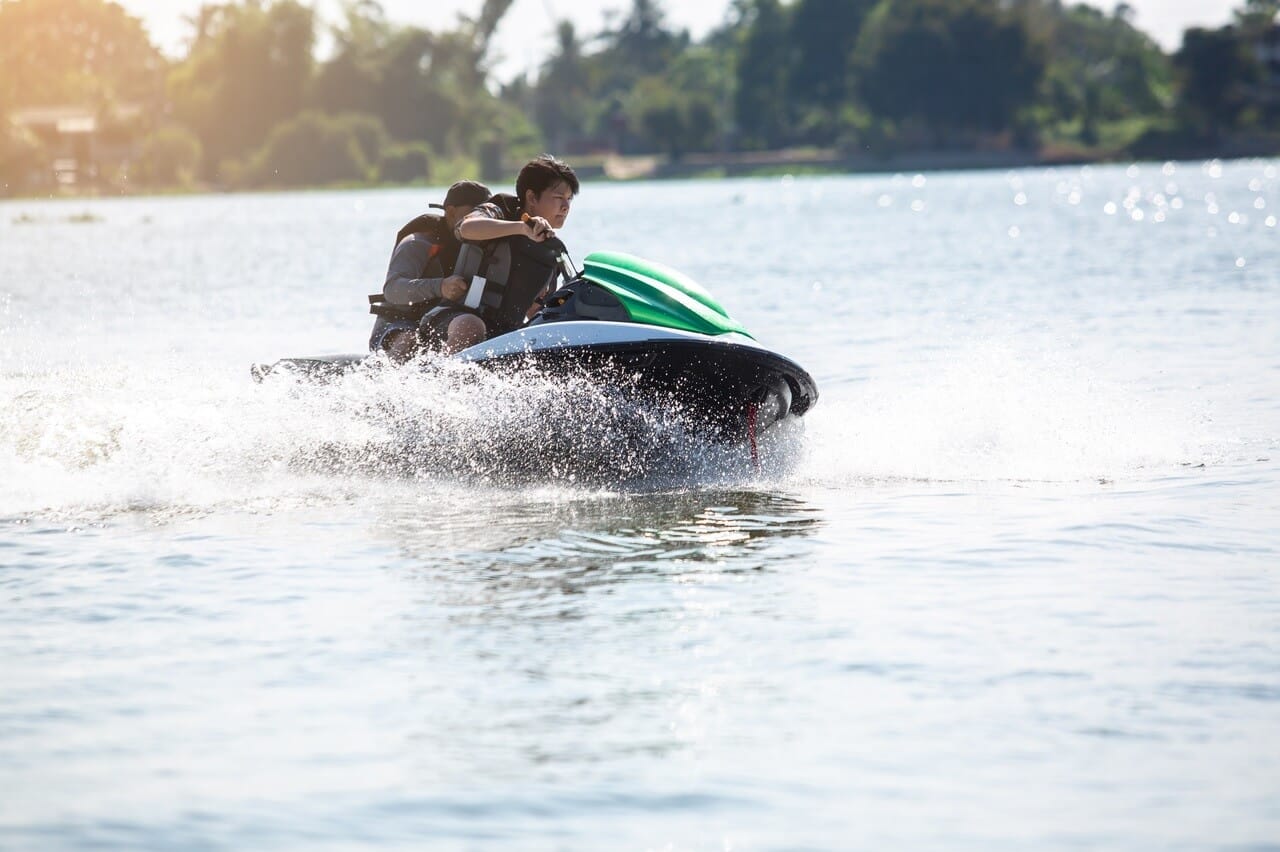Decoding Your PWC’s Steering: The Nozzle
Before you launch your personal watercraft (PWC), understanding its key components is essential for a safe and enjoyable ride. One such component, the steering nozzle, is the unsung hero of maneuverability. This guide will pinpoint its location, explain its function, and offer maintenance tips.
Where to Find the Steering Nozzle
The steering nozzle resides at the stern (rear) of your PWC, submerged underwater directly behind your seat. You won’t see it unless the PWC is out of the water. This strategic position is crucial for how it controls your PWC’s direction.
How the Steering Nozzle Works
The steering nozzle works in conjunction with the jet pump, the heart of your PWC’s propulsion. The jet pump draws water in and expels it with force, creating thrust. The steering nozzle directs this powerful jet of water, acting like a rudder.
Turning the handlebars adjusts the angle of the nozzle, changing the direction of the thrust. Turn right, and the nozzle angles right, directing the water jet left and turning the PWC right. The opposite happens when you turn left. It’s a simple yet effective principle.
Steering Nozzle Components and Maintenance
While the specifics vary between models, most steering nozzles likely incorporate internal vanes or deflectors to direct the water flow. This intricate system, though mostly hidden, is vital for your control.
Because the nozzle is constantly submerged, regular maintenance is key. Debris like seaweed, fishing line, or small rocks can clog the nozzle and impede steering. Regular cleaning, inspection, and lubrication are essential for optimal performance. Consult your owner’s manual [https://www.lolaapp.com/] for specific maintenance recommendations for your PWC model.
PWC Steering Nozzle: Mastering Control and Maintenance
The Heart of Control: Your PWC’s Steering Nozzle
The steering nozzle isn’t just a part; it’s the core of your PWC’s agility. Its location and function are fundamental to understanding how your craft responds to your commands.
Pinpointing the Nozzle’s Position
Located at the stern, submerged beneath the waterline, the steering nozzle sits directly behind where you sit on your PWC. Though hidden from plain sight, it works tirelessly to translate your steering inputs into directional changes.
From Handlebars to Water Jet: How Steering Happens
The handlebars are directly linked to the steering nozzle via a cable system or hydraulics. When you turn the handlebars, you adjust the nozzle angle, redirecting the powerful water jet expelled by the impeller. This redirection is what causes the PWC to turn. This is similar to how you can direct the water flow from a garden hose, although amplified and refined by your PWC’s engineering.
Maintaining Peak Performance: Nozzle Care
Just like any mechanical component, the steering nozzle requires regular maintenance. Its constant submersion exposes it to potential debris and corrosion. Regular cleaning prevents obstructions from hindering performance. Lubricating the moving parts ensures smooth operation and helps prevent corrosion and binding. Scheduled inspections can catch potential damage early, preventing more serious problems down the line.
Advanced PWC Steering: Beyond the Basics
While this explanation provides a general understanding, modern PWCs often incorporate additional features. Some models offer electronic trim, allowing for fine-tuned adjustments to the nozzle angle for optimal performance based on water conditions and riding style. More advanced systems may include electronic steering for even greater precision and responsiveness. Consult your owner’s manual [https://www.lolaapp.com/] or contact a qualified mechanic for more information on your specific PWC.
The Science of Steering: Ongoing Research
Current research in hydrodynamics and material science constantly seeks to enhance steering nozzle efficiency and maneuverability. Experimentation with new designs may lead to future advancements, refining the PWC experience even further. This may include research into nozzle shape, materials, and integration with electronic control systems.
Jet Ski Steering: Location and Importance
Unlocking Jet Ski Control: The Steering Nozzle
Understanding your jet ski’s steering nozzle is fundamental for any rider. This guide will break down its location, function, and why it matters.
Where’s the Nozzle?
The steering nozzle is at the very back (stern) of the jet ski, underwater. This submerged location is key to its function, which is redirecting the water jet that propels and steers your craft.
How Does It Work?
The nozzle is connected to the handlebars. When you turn the handlebars, you’re adjusting the nozzle’s angle, which redirects the powerful jet of water produced by the jet pump. This redirection pushes the back of the jet ski in the opposite direction of the jet, allowing you to turn. It’s a simple but powerful principle, and the precise location of the nozzle maximizes its effectiveness, akin to how a rudder works on a larger vessel.
Keeping It in Shape: Maintenance Matters
Regular cleaning is vital to prevent debris from clogging the nozzle, which can affect steering performance. Inspection for damage, such as cracks or bends, is highly recommended. Lubrication keeps moving parts functioning smoothly and helps prevent corrosion. Regular maintenance is not just about performance; it’s about safety. A well-maintained steering system ensures you have reliable control of your jet ski.
The Future of Jet Ski Steering
While the core principles remain consistent, ongoing research in hydrodynamics and material science continually seeks refinements. Manufacturers experiment with innovative designs to minimize drag and maximize thrust, suggesting future jet skis might have even more responsive steering. This ongoing evolution underscores the importance of understanding your jet ski’s steering system. Consult your owner’s manual [https://www.lolaapp.com/] for specific information on your model and any recommended maintenance procedures. Remember, professional advice is always best if you encounter any issues or have questions about repairs.
Boat (PWC) Steering Nozzle Explained
Decoding PWC Steering: The Role of the Nozzle
While similar in concept to a larger boat’s rudder, the PWC steering nozzle operates with a distinct mechanism. This guide will shed light on its location, function, and maintenance.
Finding the Steering Nozzle
The steering nozzle is located at the rear of the PWC, submerged underwater, out of sight unless the craft is out of the water. This position is crucial for its function in directing the water jet.
How the Nozzle Steers Your PWC
The PWC’s jet pump draws water in and expels it forcefully, propelling the craft forward. The steering nozzle precisely directs this forceful jet of water. Moving the handlebars adjusts the angle of the steering nozzle, thus changing the direction of the water jet and steering the PWC.
The Importance of Nozzle Maintenance
The steering nozzle’s constant submersion exposes it to debris and potential corrosion. Regular cleaning, especially after saltwater use, is essential. Flushing the system with fresh water and lubricating moving parts with a waterproof lubricant can significantly extend the nozzle’s lifespan and ensure smooth, reliable steering.
Ongoing Advancements in Steering Technology
While the basic principle remains unchanged, researchers constantly explore ways to improve steering nozzle design and function. Some newer PWCs incorporate electronic steering systems for enhanced precision and control, reflecting ongoing advancements in this field.
Mastering PWC Control
Understanding your PWC’s steering nozzle is fundamental to safe and enjoyable operation. Consult your owner’s manual [https://www.lolaapp.com/] for specific instructions and recommendations regarding your model. This knowledge empowers you to better control your PWC, enhancing your overall riding experience and promoting responsible PWC use. Learn about the different types of jewelry which are allowed and not allowed for food handlers to wear what jewelry can food handlers wear.
Find out who is legally responsible for littering from a motor vehicle who is responsible for littering from a motor vehicle.
- Georgia Platform: A Southern Strategy, 1850s - March 31, 2025
- How many weeks is 40 days: Quick Conversion Guide for Accurate Results - March 31, 2025
- How many feet is 300 meters? 984 Feet: Understand Length Conversions Easily - March 31, 2025
















